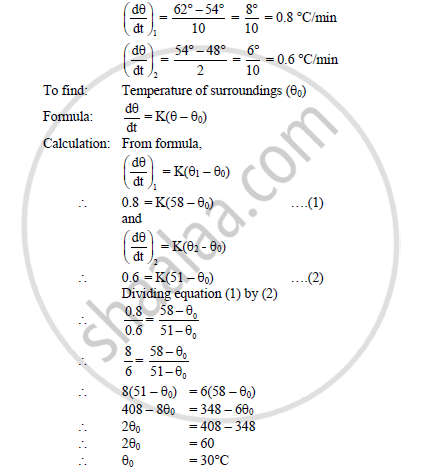Advertisements
Advertisements
Question
A body cools from 62°C to 54°C in 10 minutes and to 48°C in the next 10 minutes. Find the temperature of the surroundings.
Solution


Temperature of surroundings is 30°C
APPEARS IN
RELATED QUESTIONS
Define emissive power and coefficient of emmision of a body.
A metal sphere cools at the rate of 4°C / min. when its temperature is 50°C. Find its rate of cooling at 45°C if the temperature of surroundings is 25°C.
The light from the Sun is found to have a maximum intensity near the wavelength of 470 nm. Assuming the surface of the Sun as a black body, the temperature of the Sun is _____________.
[Wien's constant b = 2 .898 x l0- 3mK]
1000 tiny mercury droplets coalesce to form a bigger drop. In this process, temperature of the drop _______ .
(A) increases
(B) may increase or decrease
(C) decreases
(D) does not change
The kinetic energy per molecule of a gs at temperature T is ________.
(a) `(3/2)RT`
(b) `(3/2)K_BT`
(c) `(2/3) RT`
(d) `(3/2)("RT"/M)`
A body cools from 80° C to 70° C in 5 minutes and to 62° C in the next 5 minutes. Calculate the temperature of the surroundings.
Does the temperature of a body depend on the frame from which it is observed?
The length of a brass rod is found to be less on a hot summer day than on a cold winter day as measured by the same aluminium scale. Can we conclude that brass shrinks on heating?
Which of the following pairs may give equal numerical values of the temperature of a body?
The temperature of water at the surface of a deep lake is 2°C. The temperature expected at the bottom is
A spinning wheel is brought in contact with an identical wheel spinning at identical speed. The wheels slow down under the action of friction. Which of the following energies of the first wheel decreases?
(a) Kinetic
(b) Total
(c) Mechanical
(d) Internal
When a solid melts or a liquid boils, the temperature does not increase even when heat is supplied. Where does the energy go?
Water equivalent of a body is measured in ___________ .
A metre scale made of steel is calibrated at 20°C to give correct reading. Find the distance between the 50 cm mark and the 51 cm mark if the scale is used at 10°C. Coefficient of linear expansion of steel is 1.1 × 10–5 °C–1.
The volume of a glass vessel is 1000 cc at 20°C. What volume of mercury should be poured into it at this temperature so that the volume of the remaining space does not change with temperature? Coefficients of cubical expansion of mercury and glass are 1.8 × 10–6 °C–1 and 9.0 × 10–6 °C–1 , respectively.
A steel rod of length 1 m rests on a smooth horizontal base. If it is heated from 0°C to 100°C, what is the longitudinal strain developed?
‘An object contains more heat’- is it a right statement? If not why?
Define one mole.
Two objects are said to be in thermal contact if they can exchange heat energy.
One day in 1922, the air temperature was measured at 59°C in the shade in Libya ______.
Temperature in the form of energy.
The normal temperature of our body is 37°C.
Give reasons for the following:
Hot metal ball of 80° C is dipped into water of 80°C. The ball will not contract.
